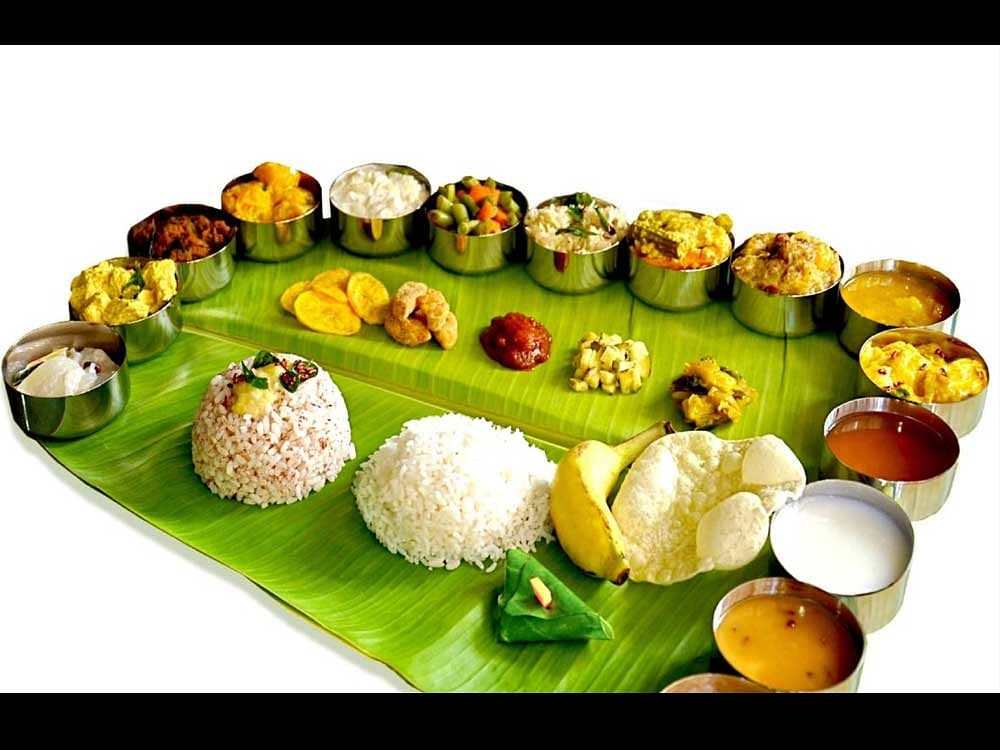
It’s that time of the year again. Onam is around the corner. Onam arrives in Bengaluru rather quietly, with little of the pomp and fanfare that heralds its imminent arrival in Kerala. Beyond a sudden proliferation of “ONAM SADYA AVAILABLE HERE” boards in front of Kerala food restaurants, things tend to be rather quiet.
However, my family usually takes food very seriously, and on Onam this obsession borders on the insane. The menu discussion begins at least a week in advance, in the proper setting — dining table cleared, pen and paper brought out and a scribe assigned. Unanimous agreement is an accepted impossibility, but over the next couple of days, some progress becomes visible. Now what’s there to discuss in a traditional festival menu? I’ll come to that.
The sadya is by necessity a pot-luck affair, because of geography, quantum of work and size of the menu, but mostly because it is simply not possible any more for the entire family to gather and cook together like earlier.
The essentials
The main part of our menu includes the traditional, non-negotiable items, which make Onam, well, Onam. But we also include a number of additions; some borrowed from Bengaluru — where we live, some from Kerala, and some can only be from my mother’s imagination. I refuse to accept that there is an actual dish called “bird’s nest” (which apparently is made of vermicelli and peas).
The number of dishes in a sadya vary according to region or personal preferences, but the key components are avial, injipuli, pachadi, sambar, thoran, kaalen, pappadum, payasam or/ and pradhaman, served on a banana leaf according to specific rules. These also tend to vary by region.
Most of the dishes are served on the leaf before the guests are seated. Injipuli, and other pickles are placed on the top left of the leaf. Below this and across the spine of the leaf are pappadum, plantain chips, sharkaraupperi and a banana. All the different varieties of kari are placed above the spine, in a row from left to right — istoo, olan, pachadi, kichadi, avial, erisseri, kootukari and kaalan. Below the spine, on the lower right of the leaf is usually the payasam and pradhaman. Rice is served after the guests are seated, to be accompanied by sambar. The correct way to partake of a sadya is said to be from left to right, from mild to the more intense flavours. The sadya in our family includes the following signature dishes:
Injipuli: Grated ginger, jaggery and tamarind in a tart, spicy sauce that is a thottukootankari — to be dipped into like pickle, not poured like sambar. There are usually two to three other pickles or chutneys in this category.
Savouries: Plantain chips and sharkaraupperi (made with chunks of yam and jaggery).
Pappadum: The pappadum has to puff up into a perfectly golden globe that crumbles into delicate shards as soon as you tap it. Available in the markets only around Onam, a pappadum that doesn’t puff up spells catastrophe — both for the cook as well as for the shopkeeper.
Pachadi: A light, cooling dish that is the perfect counterpoint to the spicy injipuli, this is a yogurt-based dish. Variants include beetroot and pineapple.
Avial: The prince of the sadya, avial is a melange of vegetables — yam, plantain, pumpkin, carrots, beans and drum sticks, seasoned with coconut oil and curry leaves.
Kootukari: Vegetables like raw banana or yam cooked with chickpeas, coconut and black pepper.
Thoran: A generic name that refers to any lightly cooked vegetable seasoned with mustard seeds and curry leaves and garnished with grated coconut. In our family of opinionated eaters, this genre has narrowed to mean either cabbage or beans thoran.
Sambar: No explanation needed for what is perhaps the most well-travelled dish of the southern states. In a sadya, this is the first ozhichukootankari — a curry meant to be poured onto the rice.
Kaalan: Served after the
sambar, this delicious kari is a yellow yogurt-based dish that is made with ash gourd or raw banana.
Payasam and pradhaman: The average sadya usually has both, a payasam that has a base of milk and sugar and a pradhaman that has a base of coconut milk and jaggery. The popular choices are pal payasam (vermicelli) and parippu (dal) pradhaman. Contemporary variants include tender coconut, jackfruit or pineapple.
Bon appétit
The afternoon of the sadya finds a constant stream of people trooping in and out of the matchbox we call a kitchen, with one noble intent or the other. This usually goes on for some time before we start hearing shrieks from the kitchen about mysteriously disappearing pappadums.
While my mother and aunt take turns as guardians of the pappadums, we are still adding finishing touches to our never-ending pookkalam. When we finish, it’s a work of art. Just like the sadya. Laid out on freshly washed banana leaves, the colours and flavours of the various dishes
come together in a perfectly balanced composition, as beautiful as a Mozart symphony. It seems almost wrong to disturb it. And then the stomach growls, loud and strident.
Happy Onam! May your pappadum always puff up and your payasam never spill.